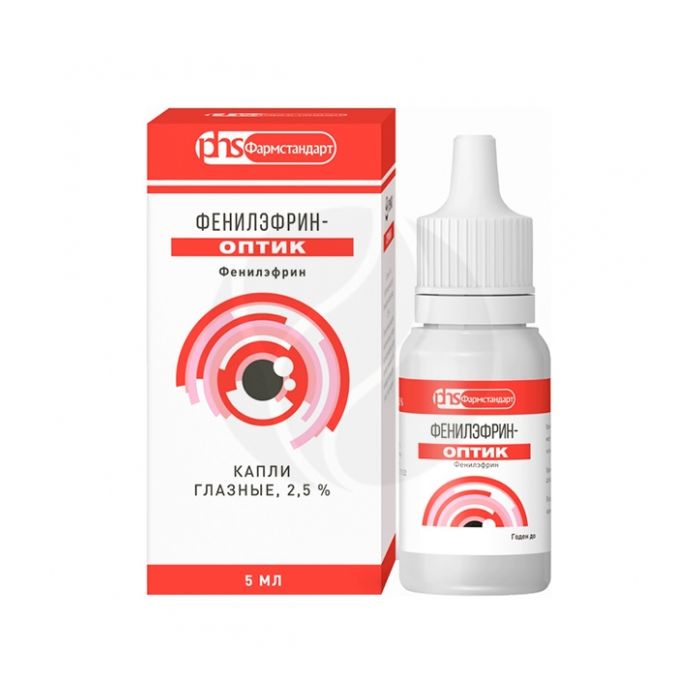Phenylephrine-Optic drops 2.5%, 5 ml No. 1
Expiration Date: 05/2027
Russian Pharmacy name:
Фенилэфрин-Оптик капли 2,5%, 5 мл №1
Locally.
With iridocyclitis, the drug is used to prevent the development and rupture of already formed posterior synechiae; to reduce exudation into the anterior chamber of the eye.
For this purpose, 1 drop of the drug is instilled into the conjunctival sac of the diseased eye (s) 2-3 times a day.
When carrying out ophthalmoscopy, a single instillation of the drug is used. As a rule, instillation of 1 drop of the drug into the conjunctival sac is sufficient to create mydriasis. The maximum mydriasis is achieved in 15-30 minutes and lasts for 1-3 hours.
If it is necessary to maintain mydriasis for a long time, repeated instillation of the drug is possible after 1 hour.
For diagnostic procedures, a single instillation of the drug is used:
- as a provocative test in patients with a narrow anterior chamber angle profile and suspected angle-closure glaucoma. If the difference between the values ??of intraocular pressure before instillation of the drug and after dilatation of the pupil is from 3 to 5 mm Hg. Art., then the provocative test is considered positive;
- for differential diagnosis of the type of injection of the eyeball: if, 5 minutes after instillation of the drug, there is a narrowing of the vessels of the eyeball, then the injection is classified as superficial, while the redness of the eye persists, it is necessary to carefully examine the patient for the presence of iridocyclitis or scleritis, as this indicates the expansion of deeper vessels.
To relieve the spasm of accommodation in children from 6 years of age and adults, the drug is instilled 1 drop into each eye at night every day for 4 weeks.
Eye drops in the form of a transparent, colorless or brownish-yellow liquid.
1 ml
phenylephrine hydrochloride 25 mg
Excipients: benzalkonium chloride (in terms of anhydrous substance) - 0.1 mg, disodium edetate - 1 mg, sodium hydroxide - 0.24 mg, sodium disulfite - 3 mg, citric acid monohydrate - 1 mg, sodium citrate dihydrate - 5 mg, purified water - up to 1 ml.
Arterial hypertension,
severe atherosclerosis,
tendency to spasms of the coronary vessels,
hypersensitivity to phenylephrine.
pharmachologic effect
Adrenomimetic. It has a direct stimulating effect mainly on ?-adrenergic receptors.
With systemic use, it causes narrowing of arterioles, increases OPSS and blood pressure. Cardiac output does not change or decreases, which is associated with reflex bradycardia (increased vagus tone) in response to hypertension. Phenylephrine does not raise blood pressure as sharply as norepinephrine and epinephrine, but it lasts longer. This, apparently, is due to the fact that phenylephrine is more stable and is not destroyed under the influence of COMT.
When applied topically, phenylephrine has a pronounced vasoconstrictor effect, causes mydriasis, and can lower intraocular pressure in open-angle glaucoma.
In average therapeutic doses, it practically does not affect the central nervous system.
Side effect
From the side of the cardiovascular system: possible undesirable prolonged increase in blood pressure, tachycardia or reflex bradycardia.
Local reactions: possibly irritating effect on mucous membranes
Application during pregnancy and lactation
There have been no adequate and strictly controlled clinical studies of the safety of phenylephrine during pregnancy and lactation.
Application in children
When applied topically after absorption through the mucous membrane, phenylephrine can cause systemic effects. In this regard, the use of phenylephrine in the form of 10% eye drops in infants should be avoided.
Use in elderly patients
When applied topically after absorption through the mucous membrane, phenylephrine can cause systemic effects. In this regard, the use of phenylephrine in the form of 10% eye drops in elderly patients should be avoided.
special instructions
The use of phenylephrine should be avoided in patients with severe hyperthyroidism.
Use with caution in coronary artery disease.
When applied topically after absorption through the mucous membrane, phenylephrine can cause systemic effects. In this regard, the use of phenylephrine in the form of 10% eye drops in infants and elderly patients should be avoided.
Drug interactions
When using phenylephrine against the background of general anesthesia caused by halothane or cyclopropane, ventricular fibrillation may develop.
With simultaneous use with MAO inhibitors, there is a potentiation of the effects of phenylephrine (including when applied topically).
Phenothiazines, alpha-blockers (phentolamine), furosemide and other diuretics reduce the vasoconstrictor effect of phenylephrine.
Guanethidine enhances the mydriatic effect of phenylephrine (with systemic absorption).
Oxytocin, ergot alkaloids, tricyclic antidepressants, furazolidone, procarbazine, selegiline, sympathomimetics increase the pressor effect, and the latter also increase arrhythmogenicity.
With simultaneous use of beta-blockers reduce cardiac stimulating activity; against the background of reserpine, arterial hypertension is possible (due to the depletion of reserves of catecholamines in adrenergic neurons, sensitivity to sympathomimetics increases).

